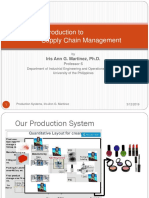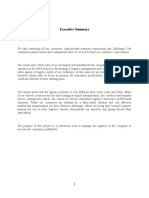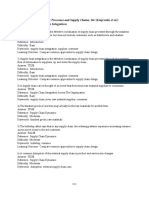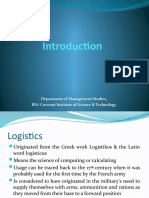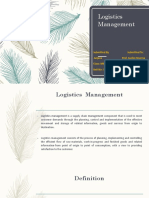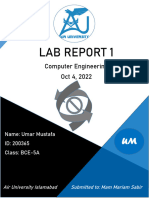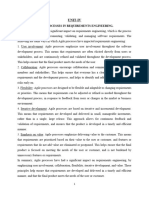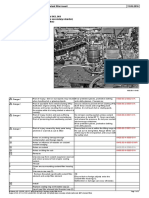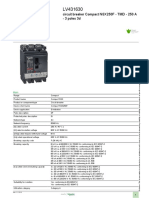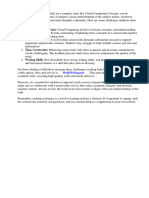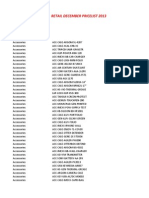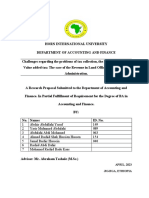LOGISTICS MANAGEMENT
MBA 031-SUPPLY CHAIN MANAGEMENT
MBA 3rd SEMESTER FACULTY DILIP KUMAR GUPTA ASSISTANT PROFESSOR (SRGC-IC)
SHRI RAM COLLEGE OF MANAGEMENT
MUZAFFARNAGAR
�LOGISTICS MANAGEMENT
�ORIGIN OF LOGISTICS
The word logistic has originated from Greek word Logistikos and the Latin word Logisticus which means science of computing & calculating In ancient times it was used more in connection with moving armies, the supplies of food & armaments to the war front. During World War II logistics gained importance in army operations covering the movement of supplies , men & equipment across the border Today It has acquired the wider meaning and is used in the business for the movement of material from suppliers to the manufacturer and finally the finished goods to the consumers
�Logistics - Science of managing (controlling) the movement and storage of goods (or people) from acquisition to consumption. Goods: Raw Materials Final products, and everything in between. Logistics for services & people similar to goods logistics. Ex. Police, fire, ambulance, passenger airlines, taxi cabs, etc. Movement Storage
Suppliers
= Transportation (between locations). = Inventory, Warehousing (at locations).
Manufacturers Warehouses & Distribution Centers Customers
Material Costs
Transportation Costs
Manufacturing Costs
Transportation Costs
Inventory Costs
Transportation Costs
�LOGISTICS
Logistics is the . . . process of planning, implementing, and controlling the efficient, effective flow and storage of goods, services, and related information from point of origin to point of consumption for the purpose of Satisfying customer requirements.
Suppliers Manufacturers Warehouses & Distribution Centers Customers
Material Costs
Transportation Costs Manufacturing Costs
Transportation Costs Inventory Costs
Transportation Costs
�Logistics
Logistics is an effort to deliver:
the right product in the right quantity in the right condition to the right place at the right time for the right customer at the right cost
�OBJECTIVES OF LOGISTICS MANAGEMENT
1. INVENTORY REDUCTION:- Traditionally firms used excess inventory , the funds thus invested are blocked and cannot be used for any other productive purpose. Hence the prime objective of logistics is to maintain the inventory at the minimum level. 2. RELIABLE AND CONSISTENT DELIVERY PERFORMANCE:-The other objective of logistics should be consistency in delivery performance, this will help in building customer confidence and contribute to long term relationships.
�3. FREIGHT ECONOMY :- Freight is the major
cost element in logistical cost .This can be reduced by adopting measures like right transport mode selection , route planning etc. 4. MINIMUM PRODUCT DAMAGES :-Product damages add to logistical cost. Reasons for product damages are :Improper logistics packaging , frequent consistent handling , absence of load unitizing etc.
�5.Quick response :- This aspect is related with the capability of the firm to provide better service to the customer in the shortest time frame. For this :1.Latest technology can be used in information processing and communication. 2.Which will enhance the decision making capability in terms of accuracy and time. 3. Enabling the enterprise to be flexible enough to fulfill the customer requirements in terms of volume and varieties in the shortest time frame.
�OPERATIONS OF LOGISTICS
1) Material Management. 2) Physical Distribution Management.
�Logistics Material Management
Manufacturing and supply services
Physical distribution management
Customer service
Suppliers
Ram materials Sub assemblies Manufactured parts Packaging material
Inbound
WIP
produc tions
FGs
Outbound finished goods
Materials flow
Inventory in the field
Transit depot
intermediary
Customer Other equipment manufacturers End users Government Operations of Logistics
�ROLE OF LOGISTICS IN SUPPLY CHAIN MANAGEMENT
1) Connects the source of supply with the demand :-
logistics basically connects the source of supply with source of demand. To do this all the components of a logistics system like warehousing network , transportation network ,,inventory control system, come into operation with the objective of providing the right product at the right time at least cost
�2) Fills the gap between supply and demand:Logistics makes it possible to deliver the product to the customer anywhere , irrespective of its manufacturing location. It facilitates either to deliver a full truckload of shipment once a week/month or part of load daily. for e.g. Laptops demanded in market in August 10,000 units. Supply of 10,000 laptops may be once in a week/month or part of load daily.
�Supply Chain
SUPPLIER FACTORY DC RDC RETAILE R
Raw Materials
Finished Goods
Office
�BULLWHIP EFFECT
It refers to the increase in variance in the demand as one moves up in the supply chain from retailers to distributors to manufacturers/suppliers.
Multi-tier Suppliers
Manufacturer
Wholesale Distributo rs
Retailers
Consumers
Sales
Sales
Time
Sales
Time
Time
Sales
Time
Bullwhip Effect
15
�Case study of HP
HP experienced the bullwhip effect in the pattern of sales of its printers. Orders placed by retailer exhibited wider swings than the actual retail sales to customers. Orders placed by the printer division to the companys integrated circuit division had even wider swings.
�Case study of P&G
P&G observed bullwhip effect in the pattern of sales for pampers disposable diapers. P&G were surprised to see that the orders placed by distributors had much more variation than sales at the retail stores. Further , order of materials to suppliers had even greater variation as compared to variation at distributors , retailers and at the sales counters.
�INBOUND AND OUT BOUND LOGISTICS
INBOUND LOGISTICS OUTBOUND LOGISTICS
SUPPLIERS TO MANUFACTURERS
MANUFACTURERS TO CONSUMERS
�Supply Chain
Stores
Operations
Stores
Procurement
Warehouse
Vendor
Customer
Inbound Logistics
Out Bound Logistics
�Supply Chain
Material flow
Material flow
P r o c u r Purchase e m e n Supplier t
Stores RM
OPERATIONS (Manufacturing process)
Information flow
D Stores is FG tr i b Warehousing/ u Distribution channel ti o n Customer
Inbound Logistics
Out bound logistics
�Suppliers
Manufacturers
Warehouses & Distribution Centers
Customers
Material Costs
Transportation Costs
Manufacturing Costs
Transportation Costs
Inventory Costs
Transportation Costs
INBOUND LOGISTICS
SUPPLIER TO MANUFACTURERS
OUTBOUND LOGISTICS
MANUFACTURERS TO CUSTOMERS
�REVERSE LOGISTICS
Inbound Logistics, Supplier to Company
Outbound Logistics Company to customers
SUPPLIERS
Company
Resellers
Customers
REVERSE LOGISTICS e.g. return of goods
�LOGISTICS COSTS
CASH EXPENSES
FIXED COST
SUNK COST DIRECT COST
VARIABLE COST
MARGINAL COST
SEMI- VARIABLE COST
INDIRECT COST
NON CASH EXPENSES
�LOGISTICS SUB SYSTEMS
PROCUREMENNT /PURCHASING SUB SYSTEM
INVENTORY MANAGEMENT SUB SYSTEM
ORDER PROCESSING SUB SYSTEM
WAREHOUSING SUB-SYSTEM
RECYCLING , RETURNS AND WASTE DISPOSAL SUB-SYSTEM
ORDER SIZE SUB-SYSTEM
TRANSPORTATION SUB - SYSTEM
MATERIAL HANDLING SUB SYSTEM
�FACTORS AFFECTING LOGISTICS
1) Globalization:-Now a days business organizations are supplying products beyond the national boundaries whenever there is a market opportunity. In such a situation , the role of logistics will be to provide time and place utility of the products to the customers. 2) Focus on supply chain management:-Business organizations all over the world in order to survive in this competitive environment has shifted their focus on supply chain management i.e., integrating the process of procurement, processing and distribution to deliver value for money to customer.
�3) Outsourcing of Non-Core-competency Functional Areas:-Business
organizations are outsourcing the functional areas to experts who can do the job at the lower cost and can ,thus make operations more effective and efficient. Logistics is an area wherein most business organizations do not have necessary expertise, and which needs to be outsourced for operating effectiveness and efficiency.
�MODELS IN LOGISTICS MANAGEMENT
3) MATHEMATICAL PROGRAMMING MODELS
i) LOCATION MODELS
5) ROUTING MODELS
ii) ALLOCATION MODELS
iii) DISTRIBUTION NETWORK MODELS
6) SCHEDULING MODELS
1) FORCASTING MODELS 4) ALTERNATIVE ANALYSIS
2) INVENTORY MODELS







